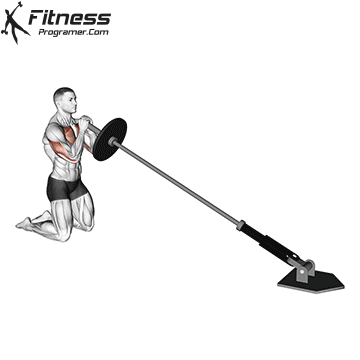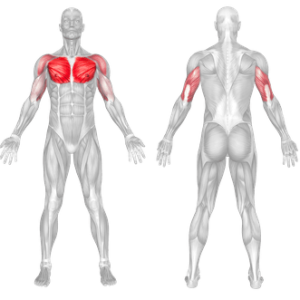Overview
The kneeling landmine press is a pushing exercise that focuses on the upper chest, with an emphasis on the anterior deltoids and triceps. Since the exercise is performed in a kneeling position, the core muscles act as stabilizers. It is often used in strength training or by those looking to focus on symmetry in the upper chest area.
How to do Kneeling Landmine Press

Setup:
- Secure one end of the barbell in a landmine attachment or against a stable surface.
- Load the free end with an appropriate weight.
Starting Position:
- Kneel on both knees with your torso upright, facing the landmine.
- Hold the bar with both hands or a single hand, positioning it at chest level.
- Keep your elbows tucked slightly in to engage the upper chest.
Pressing Movement:
- Engage your core and press the barbell forward and slightly upward.
- Extend your arm fully but do not lock out the elbow completely.
Lowering Phase:
- Slowly bring the barbell back to the starting position, maintaining control.
- Keep your chest engaged throughout the movement.
Breathing Pattern:
- Exhale as you press the weight forward.
- Inhale as you bring the barbell back down.
Tips for Proper Form:
- Maintain a straight posture to avoid lower back strain.
- Keep your core tight to prevent unnecessary movement.
- Press the bar at a controlled tempo rather than using momentum.
- Focus on engaging the upper chest by slightly tucking the elbows.
Common Mistakes:
- Leaning Too Far Forward: This reduces chest engagement and shifts strain onto the shoulders.
- Overarching the Lower Back: Can lead to discomfort and improper muscle activation.
- Using Excessive Weight: Reduces control and increases the risk of poor form.
- Not Controlling the Eccentric Phase: Lowering the weight too quickly minimizes muscle activation.
Benefits of the Kneeling Landmine Press
- Emphasizes Upper Chest Activation: Mimics an incline press for targeted pectoral development.
- Reduces Shoulder Strain: A safer pressing alternative for individuals with shoulder limitations.
- Improves Core and Stability: Engages the abdominals and obliques for balance.
- Enhances Unilateral Strength: Can be performed with one arm to correct imbalances.
- Versatile and Adaptable: Suitable for beginners and advanced lifters with easy weight adjustments.
How to Include It in Your Routine:
- Beginner Routine: 3 sets of 10-12 reps with moderate weight.
- Strength Focus: Increase weight with 3-5 sets of 6-8 reps.
- Endurance and Hypertrophy: Perform higher reps (12-15) with lighter weight.
- Pairing Strategy: Combine with pulling exercises like rows for balanced upper body development.
Muscles Worked

